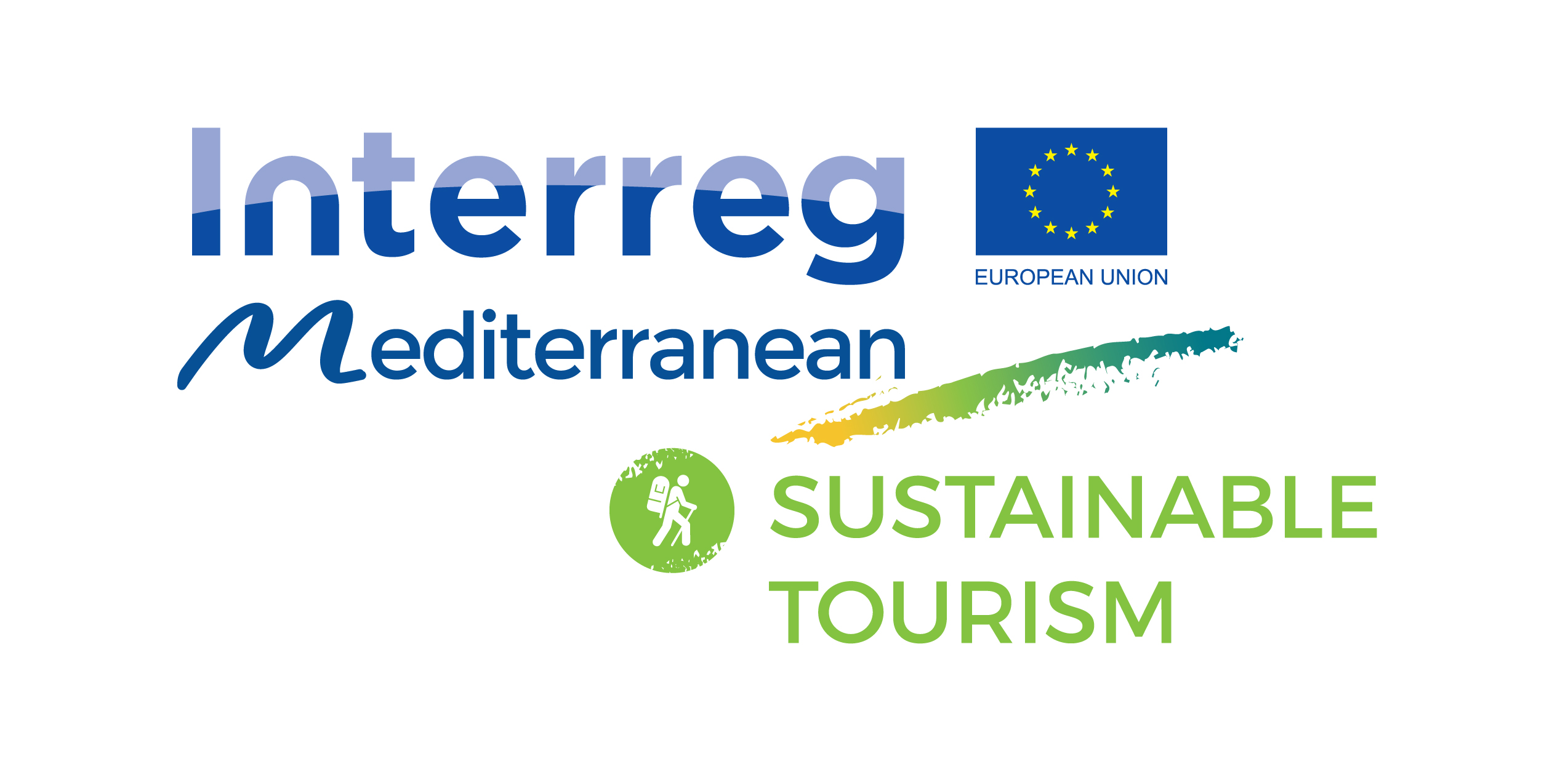Preface
This Handbook informs public authorities and tourism stakeholders in the Mediterranean about funding opportunities for projects contributing to sustainable tourism using two of the most important EU funding instruments, the Recovery and Resilience Facility (RRF) and the European Regional Development Fund (ERDF). They offer important funding opportunities for tourism at local and regional level. The guidance aims to inspire and advise readers to best prepare for absorbing these funds at regional and local levels.
Structure
The 'Funding' and '5 Key Ingredients' tabs offer you some basic information on EU funding available via the Recovery and Resilience Facility (RRF) and the European Regional Development Fund (ERDF). Tabs 'Content' through to 'Capacities' offer insights into the opportunities for sustainable tourism via national EU funding and hints for access to funding and successful implementation of projects. The final '+ Capacity Building' tab provides a further outlook to continue making use of available EU funds with concrete support from the Interreg MED Sustainable Tourism Community.
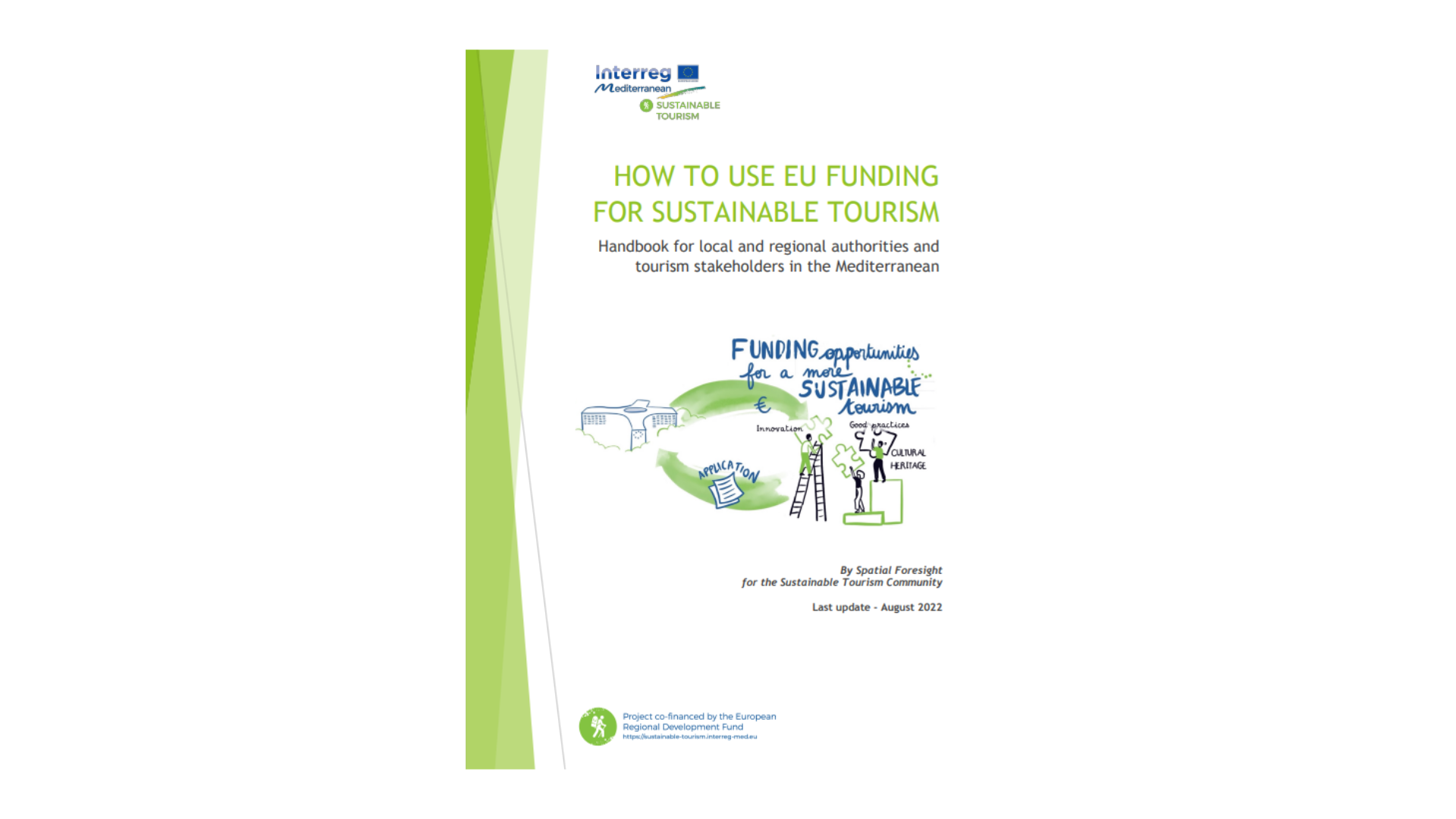
For whom is this handbook?
This handbook addresses public authorities involved in the programming and implementation of RRF and ERDF programmes as well as stakeholders that are part of the tourism ecosystem and want to invest in sustainable tourism. To achieve the recovery and regeneration of tourism and contribute to a sustainable model of tourism, all players need to collaborate, in particular local and regional authorities, regional and local tourism associations, and agencies for local and regional development and innovation. This handbook offers a common ground of basic information that should facilitate local and regional debates.
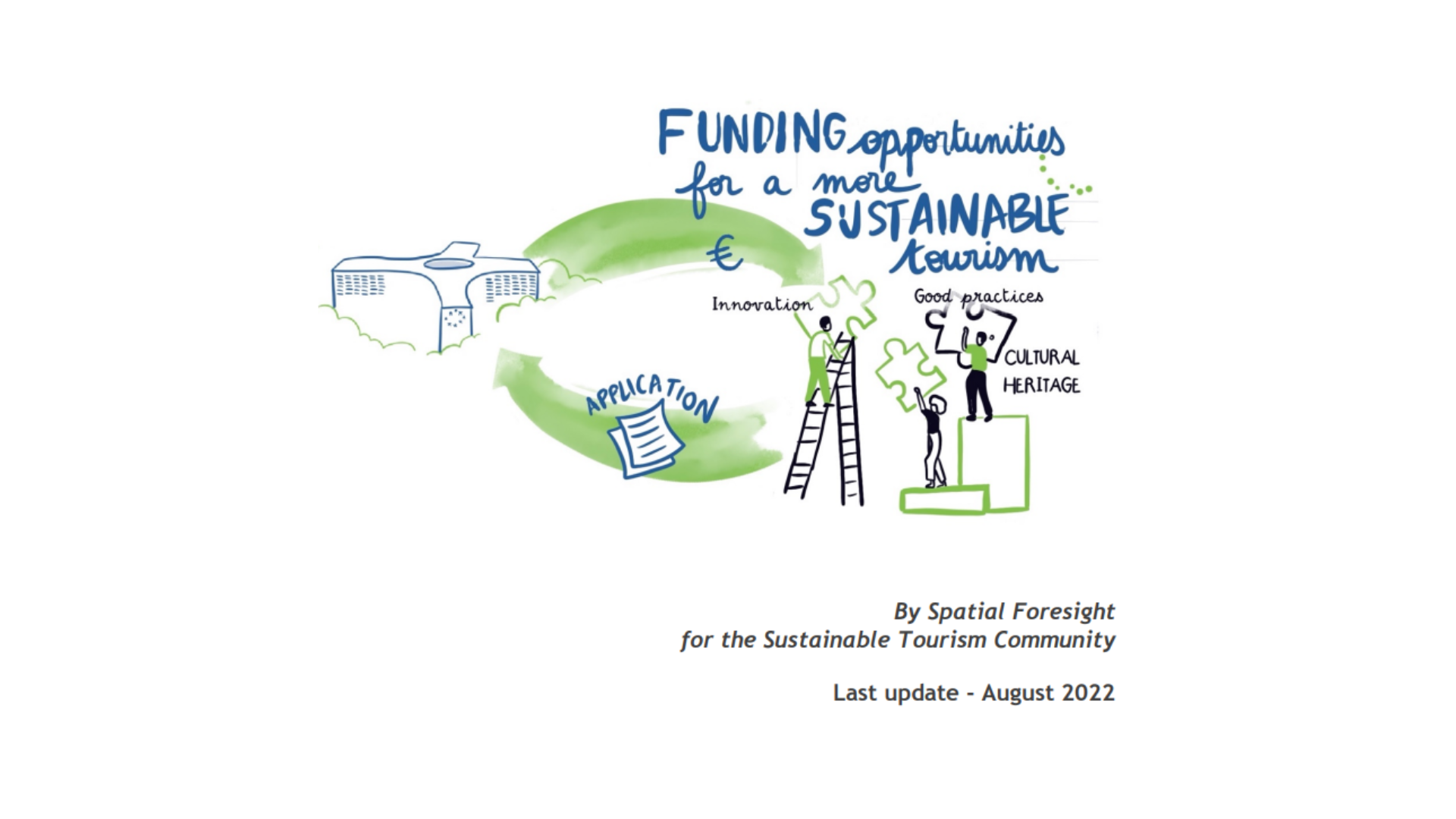
Context
The handbook is one of the capitalisation outputs of the Interreg MED Sustainable Tourism Community. The community is an INTERREG MED horizontal project. It is studying, testing, and capitalising innovative instruments and actions towards the enhancement of tourism sustainability in the Mediterranean area through 30 modular projects gathering 200+ organisations. All projects belong to the MED programme’s priority axis 3 “Natural & Cultural resources – Protecting and promoting Mediterranean natural and cultural resources”.
Authors
NECSTouR, the network of European Regions for sustainable and competitive tourism, together with the think tank Spatial Foresight, have developed this handbook. NECSTouR leads the capitalisation activities of the INTERREG MED Sustainable Tourism Community. NECSTouR is engaging its members - regional tourism authorities – to finance the recovery of the tourism sector towards the so called “tourism of tomorrow” meaning greener, digital, and more resilient. This is at the core of the network’s programme, which entitles mainstreaming the EU financial instruments available to support the tourism “twin transition: greening and digital”.
Acknowledgement
We would like to thank the representatives of tourism organisations and public authorities working with tourism and ERDF/RRF in Portugal, Spain, France, Italy, Malta, Greece, Croatia, Slovenia, and Cyprus who kindly agreed to interviews to gather more information about needs and opportunities for tourism funded by EU funds for the elaboration of this handbook.
The MED Sustainable Tourism Community
Since November 2016, the Sustainable Tourism Community has been gathering key stakeholders (mainly public authorities, private companies, universities, NGOs, and international organisations) who work actively to make tourism a real driver for inclusive and sustainable development in the Mediterranean region.
The Community relies on more than 30 territorial cooperation projects and almost 400 organisations (mainly public authorities, private companies, universities, NGOs, and international organisations) active in 13 European countries to promote sustainable tourism by capitalising on tools and good practices developed by its projects.
https://sustainable-tourism.interreg-med.eu/
@MEDCommTour
Disclaimer
This handbook does not necessarily reflect the opinion of the Sustainable Tourism Community members or representatives of the Interreg MED programme.
Sharing of the document and its content is permitted provided that the document is properly referenced. You may not change the content in any way or use it commercially.
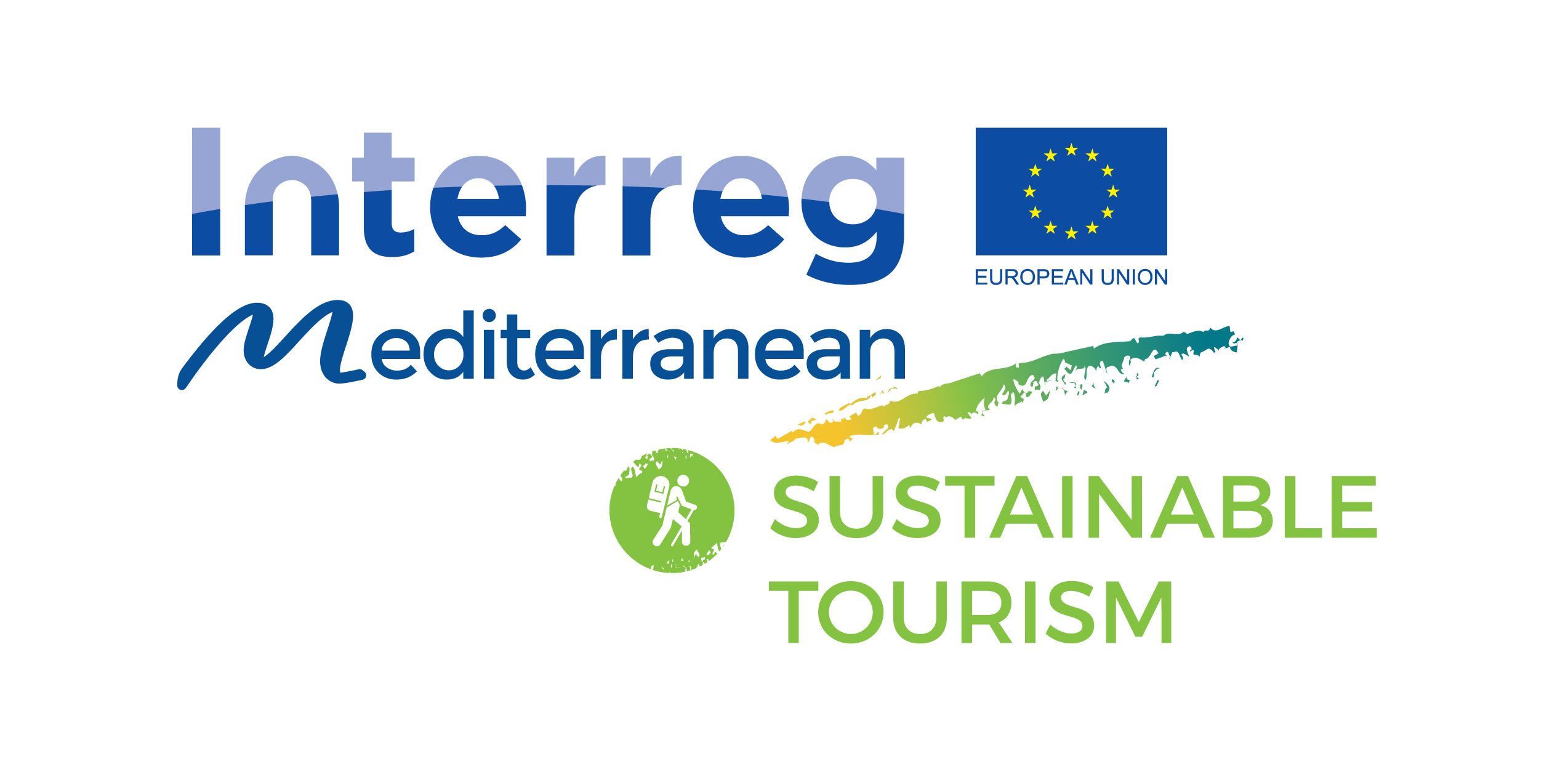
Funding for Recovery & Sustainable Tourism
This chapter contains basic information on EU funding available via the Recovery and Resilience Facility (RRF) and the European Regional Development Fund (ERDF).
2022 is a key year for recovery and the transition to sustainable tourism. The pandemic hit the sector hard. The negative effects of the travel restrictions became obvious in many regions and countries with a high dependence on the tourism sector. In other regions, less pressure from visitors during the pandemic showed a need to make tourism more responsible and connected to local communities.
The EU put new funding sources in place, notably the Recovery and Resilience Facility (RRF). The RRF is a key instrument of NextGenerationEU and aims to make Europe resilient and stronger after the COVID-19 pandemic. A vast amount of money is available to modernise the economies and, among others, enable tourism ecosystems to take up initiatives and speed up the transition to sustainable tourism. EU countries developed National Recovery and Resilience Plans (RRP) that have been implemented since the last months of 2021. For 2022 a high number of programmes, calls for projects and strategic schemes can be expected to distribute the funds towards regions, local entities and other beneficiaries.
The European Regional Development Fund is a multi-annual instrument to support regional development. The ERDF programmes aim to contribute to structural changes reducing socio-economic imbalances between European cities and regions. ERDF funds are made available via national or regional programmes that are defined by a partnership of relevant players. They address specific thematic areas, such as innovation, digitalisation, and sustainability. The ERDF is managed in sevenyear cycles of programming periods. Currently the 2014-20 funding period is in its final phases, still offering opportunities. In addition, the delayed programmes of the 2021-27 funding period are about to offer new opportunities for projects, also to the tourism sector.
This is thus an important moment to prepare for an effective distribution and use of these EU funds to transform the COVID-19 pandemic into an accelerator for sustainable tourism.
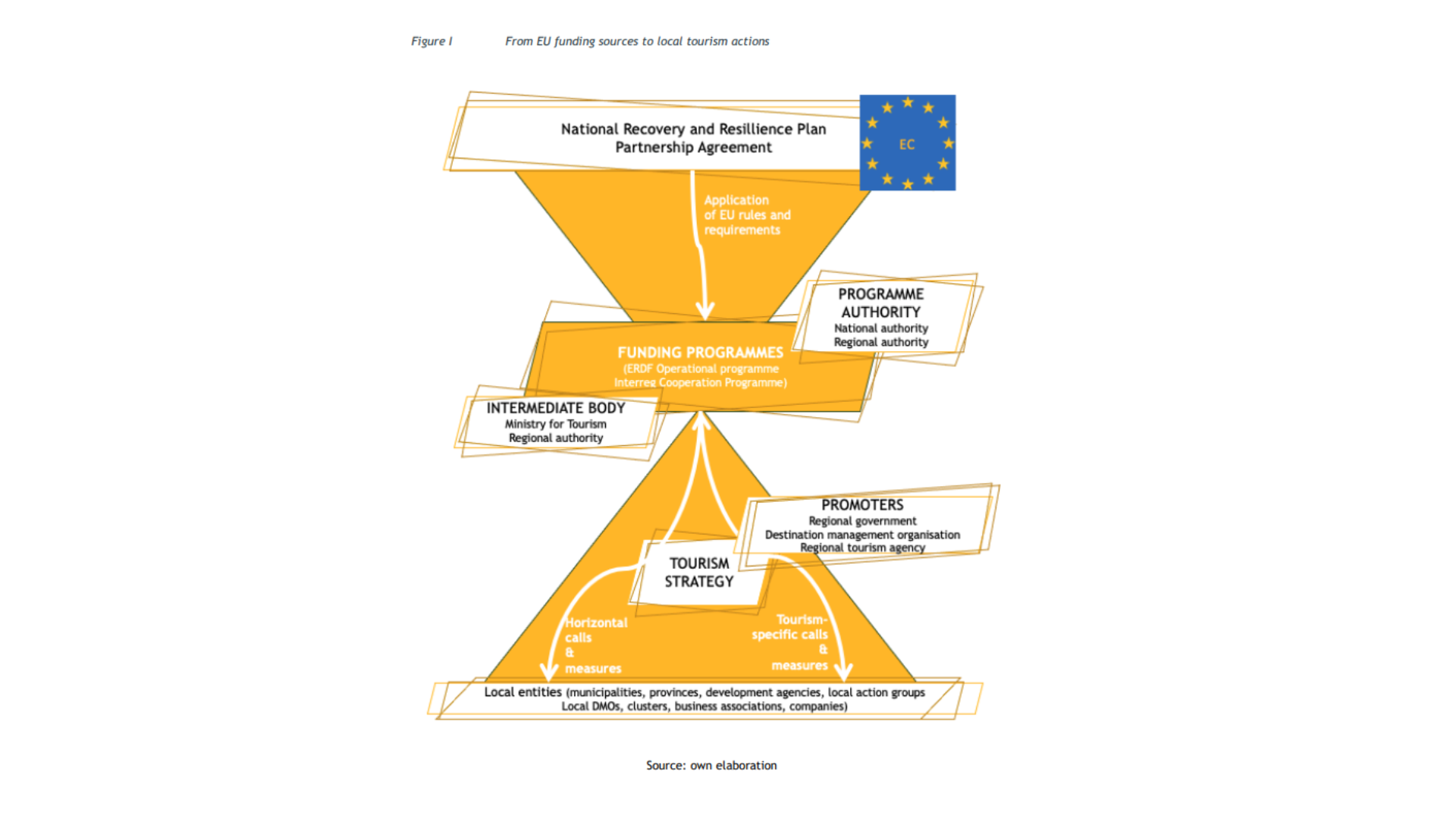
Recovery and Resilience Facility
The European Commission launched the RRF to mitigate social and economic impacts of the COVID-19 Pandemic. RRF thus aims to restore the tourism sector and make it better, more fit for the future. To do so, RRF funding needs to be quickly allocated and spent.
Funds should be made available until 31 December 2023. Milestones and targets shall be achieved by 31 August 2026. Thus, quick responses to use the available funding are necessary.
The European Commission made EUR 723.8 billion available for reforms and investments to make European societies more resilient, green and digital. Tourism related activities can be among the target reforms and investments. EU Member States are responsible for the allocation of these funds, targeting country specific needs.
National authorities prepared National Recovery and Resilience Plans (NRRP) in which they specified priorities for reforms and investments. Depending on the country and investment priority, national or regional authorities are responsible for programme management, selection of projects, and monitoring of their results.
In Italy, Greece and Portugal new coordination structures have been set up to manage RRF funding. The Recovery and Resilience Facility Agency from the Ministry of Finance manages RRF in Greece. In Italy a steering committee has been established by the Presidency of the Council of Ministers. In Portugal the task force Recuperar Portugal monitors and implements the NRRP. In the other MED countries, existing Ministries and bodies are responsible for the implementation of the NRRP, namely the Ministries of Finance in Croatia, Spain and France. In the latter supported by the General Secretariat of European affairs. In Cyprus and Malta the same ministry responsible for other European funds is responsible for the NRRP: DG European programmes, coordination and development in Cyprus and the Maltese Ministry for EU funds. These entities are thus first entry points for more information on funding opportunities.
These plans are further translated into concrete action plans and funding programmes. Line Ministries, including Ministries for Tourism, e.g. in Croatia, both the Ministry and the regional authorities, e.g. in Spain, are responsible to bring the NRRP into action. The scheme on the next page provides an exemplary pathway of how funding trickles down from EU level to tourism players.
All in all, NRRP of EU Member States around the Mediterranean address tourism. Funding available for tourism differs per country. The Italian NRRP proposes for example to invest EUR 6.68 billion out of 68.9 billion to restart tourism and culture embracing digitalisation and sustainability. Part of this sum is already allocated to specific projects indicated in the NRRP. Another part will be made available for regional and local authorities, tourism destination management organisations or tourism businesses via specific programmes or funds. In France, approx. EUR 1.24 billion out of 39.4 billion of the NRRP are partly applicable for increasing attractiveness of tourism. Among others, EUR 50 million is made available for a sustainable tourism programme. The national agency for ecological transition makes this money available to tourism players, notably accommodation providers and restaurant owners. On average tourism players receive grants of EUR 18,000 to make their business more sustainable. Regional authorities support tourism players to obtain the funds and guide them during the implementation. Large amounts of investments as announced in NNRP may thus provide small grants to individual businesses. Local and regional authorities are important interlocutors for tourism players to make use of these funds.
Additional information can be found later in the document, including a comparative table.
More information
Updated information on the plans and programmes can be accessed online. The European Commission’s webpage on the RRF provides more details in the regulation, a dashboard on the current implementation and available plans and responsible authorities.
Other initiatives provide comparative details of national plans, for example the centre for European Policy studies’ recovery and resilience monitor.
More details are presented on national webpages on the national Recovery and Resilience Plans:

European Regional Development Fund

The ERDF is one of the EU’s main instruments to encourage a balanced development between regions in which no location shall be left behind, so-called Cohesion Policy. As such, the ERDF generally supports activities contributing to structural change and socioeconomic development. Within a longterm perspective of the ERDF development programmes, short-term actions are needed to make best use of the available funding.
ERDF Funding is available via Operational Programmes in each country, managed by national and regional authorities, as well as via cooperation programmes such as INTERREG Euro-MED, INTERREG ADRION or INTERREG ALCOTRA. Interreg funding can be directly applied for in calls by the Interreg Programmes, whereas the national funding is offered via national/regional stakeholders.
Many local and regional authorities and their destination management organisations as well as other tourism players have benefitted from funding allocated via 2014-20 programmes. Unfortunately, funding opportunities for tourism activities were not always evident in these programmes, as European-wide thematic areas did not specifically address tourism needs. At the same time, the EU’s pandemic emergency relief to regions financed via the ERDF, REACT-EU, offered possibilities. REACTEU provided funding to ERDF programmes to support the sectors most affected by the Pandemic and to make countries resilient to future health crises. The government in Slovenia, for example, opened in December 2021 a call for proposals for a stronger tourism sector. Fortunately, tourism is more visible in the new programming period, 2021-27.
Now is the time to prepare for upcoming calls related to 2021-27 programmes. Programme authorities are in the final phases of programme development. New programmes are expected to be launched in Spring 2022 and first calls may be expected soon after. This provides new funding opportunities for the tourism sector.
ERDF programmes are managed by national and regional authorities, depending on the country. Mechanisms of how these funds trickle down to the local level are similar to the mechanisms for RRF and are sketched in figure 1.
Programmes present the national and regional translation of European policy objectives. Specific territorial needs and opportunities are reflected in the programme. Funding opportunities for tourism may be explicit in relation to circular economy, sustainable development and skills development. At the same time, other opportunities will be present. Tourism has already been supported in past programmes, for example, to enhance digital infrastructure and uptake of digital tools, to modernise infrastructure or to create new tourism products to fight seasonality. Supported actions differ greatly in scope and range from small investments of EUR 50,000 to complex innovation or redevelopment projects with a budget of several millions. The next section provides more inspiration on possible opportunities.
More information
The European Commission’s Directorate General for Regional and Urban development lists all programmes and managing authorities for the ERDF on their webpage: https://ec.europa.eu/regional_policy/en/atlas/
Cooperation programmes, Interreg funded via the ERDF are also listed on www.interreg.euhttp://www.interreg.eu/. More about information about Interreg and its added value as a testing ground for activities related to national and regional ERDF programmes can be found in the last section of this handbook.
Need to act to use EU funding opportunities
2022 is a key year for recovery and the transition to sustainable tourism. The pandemic hit the sector hard. The negative effects of the travel restrictions became obvious in many regions and countries with a high dependence on the tourism sector. The EU put new funding sources in place and a vast amount of money is available to, among other things, enable tourism ecosystems to take up initiatives and speed up the transition to sustainable tourism. However, despite tourism being an important sector in EU economies with strong multiplier effects and a valuable tool for sustainable local development, it is challenging to support the recovery and transition of the tourism ecosystem, given its fragmentation and the complex interdependencies of public and private elements.
Key bottlenecks that hamper the use of EU funds are:
- ERDF and RRF implementing bodies at national and regional levels are not always aware of the needs and specificities of the tourism value chain.
- Tourism stakeholders and ecosystems at local and regional level might not be familiar with the possibilities within EU funded programmes. Local and regional tourism players might have good ideas but do not know about funding opportunities.
- Communication between the ERDF/RRF implementing bodies and tourism stakeholders is not well established in many regions. Exchange of information and active dialogue needs to be improved.
Click to see Table 1 Summary information on ERDF & CF 2021-2027 and RRF per country
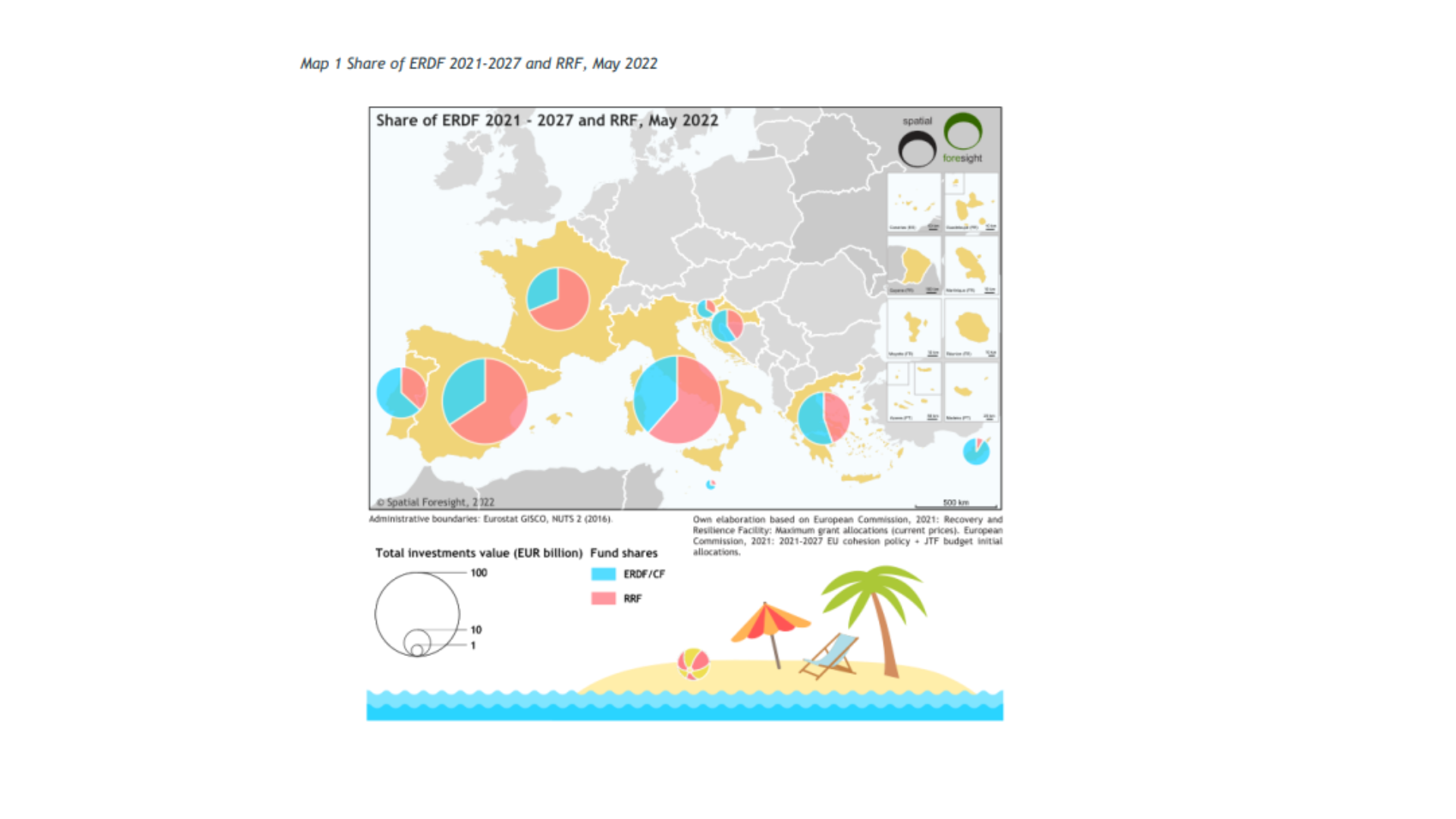
Boosting Sustainable Tourism
This chapter offers insights into the opportunities for sustainable tourism via national EU funding and hints for access to funding and successful implementation of projects.

Tourism is a major economic sector in Mediterranean regions. In 2015, 320 million international tourists came to the area, providing 11.5% of the population in Mediterranean regions with a job, and contributing to 11.6% of GDP in the region. However, many places, at least until 2019, reached levels of visitors that put pressure on local communities and the environment. To ensure communities benefit from tourism, further investment and a transition to more responsible and sustainable tourism is needed.
In May 2021, the Council of the EU presented conclusions on tourism considering the wide-ranging effects of the pandemic on the tourism sector. The conclusions encouraged Member States to “develop sustainable, responsible and resilient tourism policies and strategies”, particularly in the following areas:
a) Driving towards a sustainable and responsible tourism and business conduct.
b) Improving connectivity and multi-modal sustainable travel, taking into account cross-border, rural, insular, peripheral, and depopulated areas, as well as outermost regions.
c) Promoting sustainable coastal and maritime tourism as part of the tourism ecosystem and blue economy.
d) Promoting new technologies, digitalisation, ICT and data-sharing to enhance the performance of tourism businesses, improve tourism development planning and smart management of tourism flows, and provide seamless travel, easier communication and integrated tourism development.
e) Encouraging European wide dialogue and exchange of best practice to develop innovative approaches, including in smart tourism, for the balanced management of growing tourism flows into European destinations.
Managing authorities and implementing bodies of the EU funding instruments, at regional and local level, need to be aware on the needs and opportunities of the tourism value chain. Tourism stakeholders and ecosystems might require specific actions that go beyond the traditional business support for SMEs or manufacturing sectors. Destinations are more than the sum of tourism companies; they build on local communities, natural and cultural assets that need to be carefully managed, develop co-dependencies with local transport systems, public services, and sectors such as retail and agri-food, and connect to the cultural and creative fabric. Support programmes need to understand the needs of tourism ecosystems and the complex linkages at destination level.
At the same time, tourism players need to understand the funding frameworks, the strategic framework behind ERDF and RRP programmes and calls, and the necessary conditions to receive and implement funding.
The Five Key Ingredients
To make best use of available funding for sustainable tourism, several conditions need to be in place.
On the one hand, the public authorities who manage the ERDF and RRP funds should know that tourism ecosystems are possible beneficiaries, and that funding tourism can have important multiplier benefits. National and regional tourism authorities should analyse the needs of the sector and elaborate strategies and action plans with long-term and short-term goals.
On the other hand, relevant tourism stakeholders on the ground need to be aware on the funding opportunities and know the basic conditions to access them. This requires that important intermediate organisations such as local entities, chambers of commerce, destination management organisations or any other player relevant for the tourism sector also knows about the funding opportunities and can support the tourism players. Finally, there might be other support agencies (for example on innovation, IT or sustainability) that usually do not work with the tourism sector but would be an important part of new solutions and projects. They should open their service to support the tourism sector. ´
It is therefore necessary to dynamise the tourism ecosystem and bring the different parts together in what some call the sustainable or smart tourism destination approach.
To ensure a transparent access to EU funding and high-quality projects, five key ingredients – the five C’s – are necessary.
Recommendations on these five C’s are presented here. They target all organisations and authorities that are involved in the implementation of the ERDF and RRF funds.
On the next pages more specific recommendations are presented for potential beneficiaries of ERDF and RRF funding programmes and intermediary organisations at local and regional level. Relevant organisations can be regional governments, Destination Management Organisations, regional and local tourism agencies, tourism clusters, municipalities, provinces, development agencies, local action groups, business associations, companies.
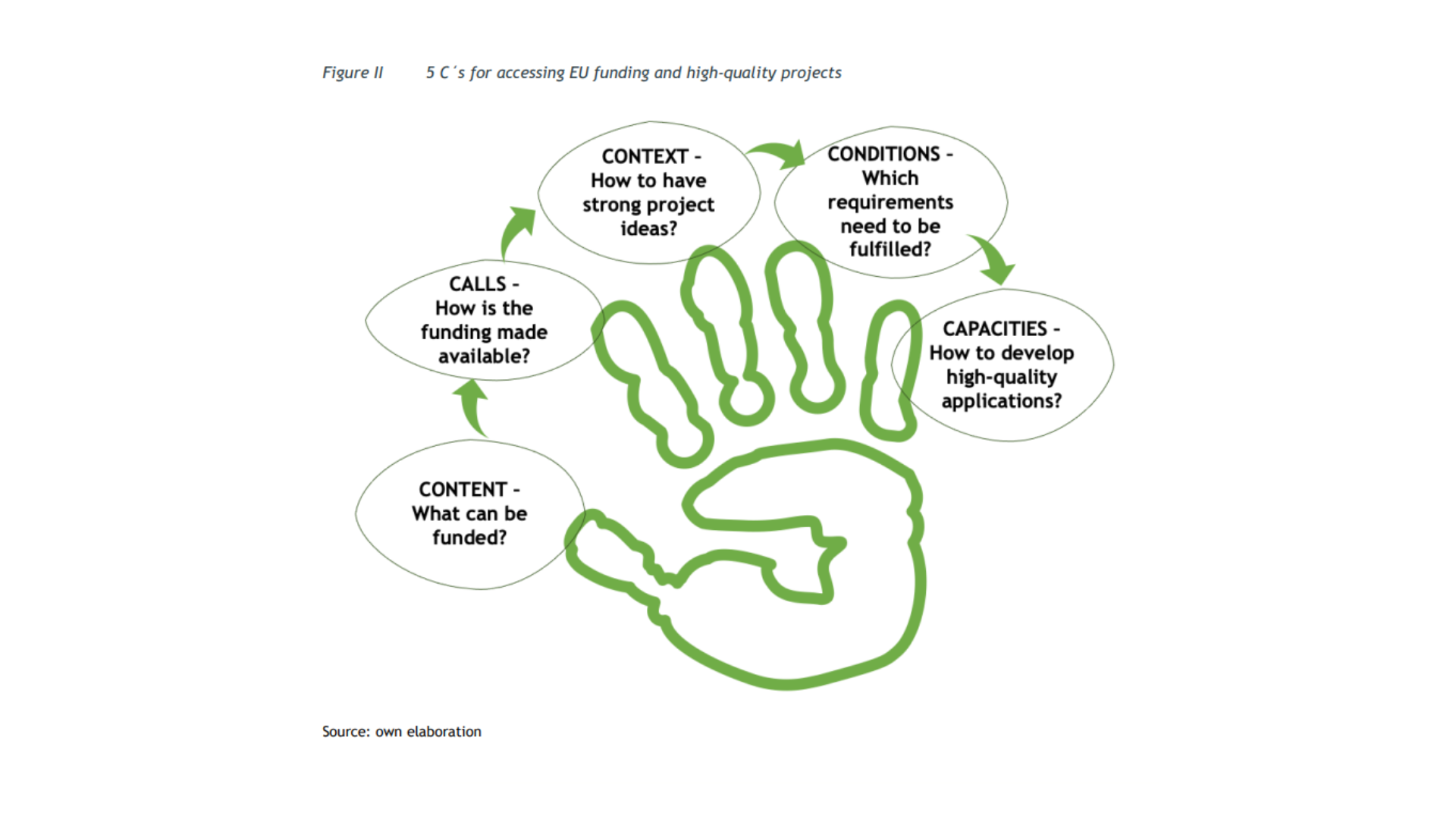
Recommendations to Managing Authorities for ERDF and RRF
Managing Authorities are interested in the efficient and effective management of ERDF and RRF programmes and in a timely good absorption of funds. It is therefore in their interest that both calls and funding schemes address real needs and lead to high-quality projects. To ensure this they should take care that relevant networks and communication tools providing information on ERDF and RRF contribute to:
- Increase the mutual knowledge on the needs and opportunities for the tourism sector within ERDF and RRF programmes/plans (across all POs and different thematic topics).
- Offer spaces for debates and exchanges between ERDF/RRF implementing bodies about specificities of the tourism sector.
- Initiate a dialogue between the relevant actors in the ERDF/RRF system and the tourism ecosystem.
Possible tools would be the active integration of different tourism players in the ERDF Monitoring Committees, or the organisation of roundtables/networks on tourism by ERDF programmes and ERDF implementing bodies within a country.
Another possibility would be to generate information on good practices of how tourism can be supported in relevant ERDF programmes in a given country.
Recommendation Implementation Bodies for ERDF and RRF
There are some organisations that are key in the implementation of ERDF and RRF programmes and schemes (e.g. in the field of innovation and SME support, digitalisation, sustainable transformation, energy) that do not have specific experience with the tourism sector and have little knowledge on the specificities of the sector. They would benefit from some suggestions on how to engage with the sector and work on their future calls and funding schemes:
- Develop tourism specific priorities and measures. Think of tourism as one target sector for horizontal priorities and measures (general calls for SMEs, digitalisation, sustainability, etc. are also relevant for the tourism value chain.
- Improve distribution of information, programme websites, newsletters, and seminars to inform about upcoming calls and opportunities. Establish links with local and regional tourism players (e.g. Clusters).
- Be aware of recent national, regional, and local tourism strategies and action plans that highlight development needs and opportunities. Be sure to understand the needs of the sector.
- Communicate clearly on programme objectives and funding requirements for application and implementation. Offer support material such as templates and good examples on how to develop a good application.
- Collaborate with partners from the tourism ecosystem. Join forces via representative bodies (e.g. DMOs, chambers of commerce, regional tourism agencies etc.). Offer capacity building and training for project promoters.
CONTENT – What can be funded?
A transition to sustainable tourism demands actions from multiple angles. Sustainable tourism; (1) makes optimal use of environmental qualities and resources in tourism development and the destination’s offer, (2) respects social-cultural authenticity of the destination, and (3) ensures viable long term economic operations.
There are many ways to promote sustainable tourism. Most of them refer to reducing the environmental effects of tourism-related activities or increasing the positive social and economic return on local communities. This can be done in numerous ways, for example introducing carbon-free travel at local level, promoting regionally produced food and beverages, or promoting eco-labels for accommodation.
RRP funding asks for a focus on digital transition and on climate-related measures, which means reducing negative effects on the environment and CO2 emissions. Moreover, investments for smart, sustainable, and inclusive growth, productivity, research, development and innovation, as well as for social and territorial cohesion, education and skills, gender equality and the economic empowerment of women are possible under the RRP. Details for each country can be found in the different National RRP documents and websites.
The ERDF proposes Policy and Specific Objectives that need to be attended, including digitalisation and innovation, climate change adaptation, circular economy approaches, renewable energy use and sustainable transport, but also education, training, and labour-related measures. ERDF projects can support the development of SMEs, contribute to the development of an inclusive digital society, for example smart cities and villages, and promote pollution-free and sustainable multimodal mobility with a focus on public transport, shared mobility, walking and cycling. ERDF projects can support ‘social economy’ entities such as cooperatives, mutual societies, non-profit associations, and social enterprises. Investments supporting the creative/cultural industries, cultural services and cultural heritage sites can be financed provided they contribute to the specific objectives. Overall, operations under the ERDF are expected to contribute 30 % of the overall financial envelope of the ERDF to climate objectives.
For the RRP, the documents and relevant thematic areas of funding are already available.
However, for ERDF each country or region can have a specific thematic focus which is described in the Operational Programme. These Programmes are not yet published, so it is still too early to analyse if a country or region will concentrate its ERDF projects on certain thematic areas.
In the context of tourism, the focus of RRP and ERDF funding can be on individual tourism businesses, for example with aid schemes to modernise the company, buy new equipment, renovate infrastructure, or introduce energy efficiency measures. Other funding actions can focus on the level of associations and clusters, for example helping them with capacitybuilding or free technical assistance to develop pilot projects, strategies, or support schemes for their members. Local entities can also benefit from the funding, for example with funding for sustainable destination strategies or training.
Tourism is explicitly mentioned in only some national RRP documents, for example, as Component 14 in the Spanish RRP “España puede”. However, still it might be inserted under horizontal actions referring to economic development in general.
Under ERDF, sustainable tourism is covered as one of the many areas of local and regional development. The approach of sustainable tourism is mentioned in the ERDF Regulation.
It should “take into account the welfare of tourists, respect the natural and cultural environment and ensure the socio-economic development and competitiveness of destinations and businesses through an integrated and holistic policy approach”.
The ERDF shall support sustainable tourism in an integrated manner, in particular through strengthening cooperation. “Enterprises and public authorities should systematically cooperate to deliver quality services more efficiently in areas with a high potential for tourism, taking due care to create a stable legal and administrative environment conducive for sustainable growth of such areas”. Supported actions around sustainable tourism could take into account best practices in this area.
Examples of how tourism might be integrated in the different ERDF Policy Objectives are:
Initiatives enhancing competitive levels and making the sector more resilient (ERDF Policy Objective 1).
- Uptake of advanced technologies in tourism
- Big data in tourism analytics as basis for data-driven planning and services
- Tourism safety through use of web-based solutions and big data
- Smart tourism destination management
- Modernisation of SMEs
- Digital connectivity and use of IT in tourism companies
- Creation of innovative tourism companies
Improvements of environmental qualities and use of resources (ERDF PO 2).
- Resource efficiency and circular approaches in tourism
- Preservation of biodiversity with calculation of carrying capacity and managing visitor flows
- Promote renewable energy in hotels and other tourism businesses
- Increase energy efficiency in tourism.
- Climate change adaptation of tourism destinations
- Sustainable urban transport
- Low-carbon transport and travel (EuroVelo routes etc.
Sustainable Transport (ERDF PO 3).
- Climate resilient and intelligent national, regional, and local mobility
- Cross-border mobility
Education and inclusion for safe and sustainable tourism (ERDF PO 4).
- Training and skills for sustainable tourism
- Improve quality of education and employment in tourism
- Social innovation for tourism
- High-quality tourism infrastructure at small local destinations
- High-quality tourism information
- Inclusive and accessible tourism
Connecting to local communities (ERDF PO 5 – only in integrated territorial strategies).
- Public participation tools and practices
- Local initiatives and community-led local development
- Platforms that connect local community, operators, local governments, and visitors
The ERDF Regulation (2021) enables support for investments in infrastructure, including; research and innovation and business infrastructure for SMEs, culture and heritage, sustainable tourism and services to enterprises, investments in relation to access to services with a particular focus on disadvantaged and segregated communities, productive investments in SMEs, equipment, software and intangible assets, as well as measures with regard to information, communication, studies, networking, cooperation, exchange of experiences between partners and activities involving clusters. Sometimes, investments in infrastructure can have important effects on tourism sustainability.
The key objective of Operational Programme North Aegean Region in Greece is to strengthen development, culture, natural heritage, sustainable tourism, and security in non-urban areas.
Within this Operational Programme the following types of projects could be financed:
- Support and protection of natural and cultural resources.
- Strategies for improving the skills and knowledge of workers, reducing unemployment, and supporting vulnerable groups.
- Support for local agencies to develop planning capacity, managing and implementing strategies for spatial planning.
This programme highlights the need to reinforce the develop planning capacity managing and implementing strategies for spatial planning
In December 2021 a call was launched in Spain to provide financial support for projects. In particular, it supports the digitalisation of tourism enterprises. This covers, for example, the development of digital business tools, the adoption of digital solutions that facilitate sales, mobile digital solutions, or the application of big data. It can also include: the design and implementation of digital strategies; development of e-commerce for tourism products and services, particularly in terms of cloud computing and mobility; design and implementation of digital marketing strategies, presence, differentiation and online reputation; digitalisation through actions such as the implementation of mobile technologies; geo-referencing; and Tourism 2.0. Other actions could cover: virtual and augmented reality; home automation and sensorisation; data capture and analysis; social platforms; network security and e-services; communication channels and interaction with customers; management and promotion of digital tourism; research into new tourism products and services; multi-channel marketing and open promotion; customer perception management; optimisation of management processes.
Circular economy approaches build not only on technological solutions but also on an effective cooperation between different actors, namely hotels, waste companies, waste collection services, the agricultural sector etc. To support circular economy is one of the priorities of the ERDF 2021-2027 and of most Recovery and Resilience Plans. For example, the island of Mallorca has elaborated the Plan “Mallorca Circular” to launch in the context of the Next Generation EU 2021-2027; different projects to stimulate circular tourism regarding the use of energy, water, mobility and food/waste, and to modernise the companies that work with residues on the island. These new projects would probably not have been proposed without the earlier experiences with pilot actions and Interreg projects.
The IMPACT project (Interreg ALCOTRA FranceItaly 2014-2020) promoted the empowerment of young people through culinary education in the French-Italian border region. 89 students enhanced their professional skills in hospitality and cooking, including regional and traditional dishes. Students benefitted from 150 digital productions (videos and webinars), over 300 hours of streaming sessions and the possibility to take up an internship in one of the 78 companies associated to the project. The project thus enhanced the skills of the future generation to prepare traditional dishes and so contributed to preserving the culinary heritage in French and Italian regions. The project was implemented by the Apro Formazione in Alba, Italy, and Faculté des Métiers, École Hôtelière in Cannes, France. The project received a total ERDF funding of EUR approx. 1 million.
The LOCATIONS project (Interreg MED 2014- 2020) developed approaches and means to help public administrations to define low-carbon transport and mobility plans, specifically aimed at cruise-related passenger and freight flows. Cruise tourism can be a blessing and a curse for destinations in the Mediterranean. On the one hand, the ships bring economic advantages and an inflow of many tourists. On the other hand, the large inflow of tourists increases pressure on the destination’s environment, transportation systems and public services including waste collection. Local and regional partners from countries across the Mediterranean area developed and implemented low-carbon transport and mobility plans in seven pilot port cities. The pilots resulted in defining modular packages for local and regional authorities to develop their own plans to balance between the positive and negative effects of cruise tourism. The package includes more than 40 example measures on, for instance, hybrid, clean and electric vehicles; port accessibility; intermodality; ticketing and tariffs; access management and road pricing; and real time and road user information.
Are there compulsory goals for all projects funded under RRP and ERDF?
Projects can contribute to economic recovery, job creation, increase of productivity, and modernisation of businesses and management, particularly SMEs. Projects can also support sustainable tourism, circular economy approaches or contribute to local development and territorial/social cohesion. Within the larger legislative framework, it depends on specific calls for Projects by national and regional authorities in each country what exactly will be funded.
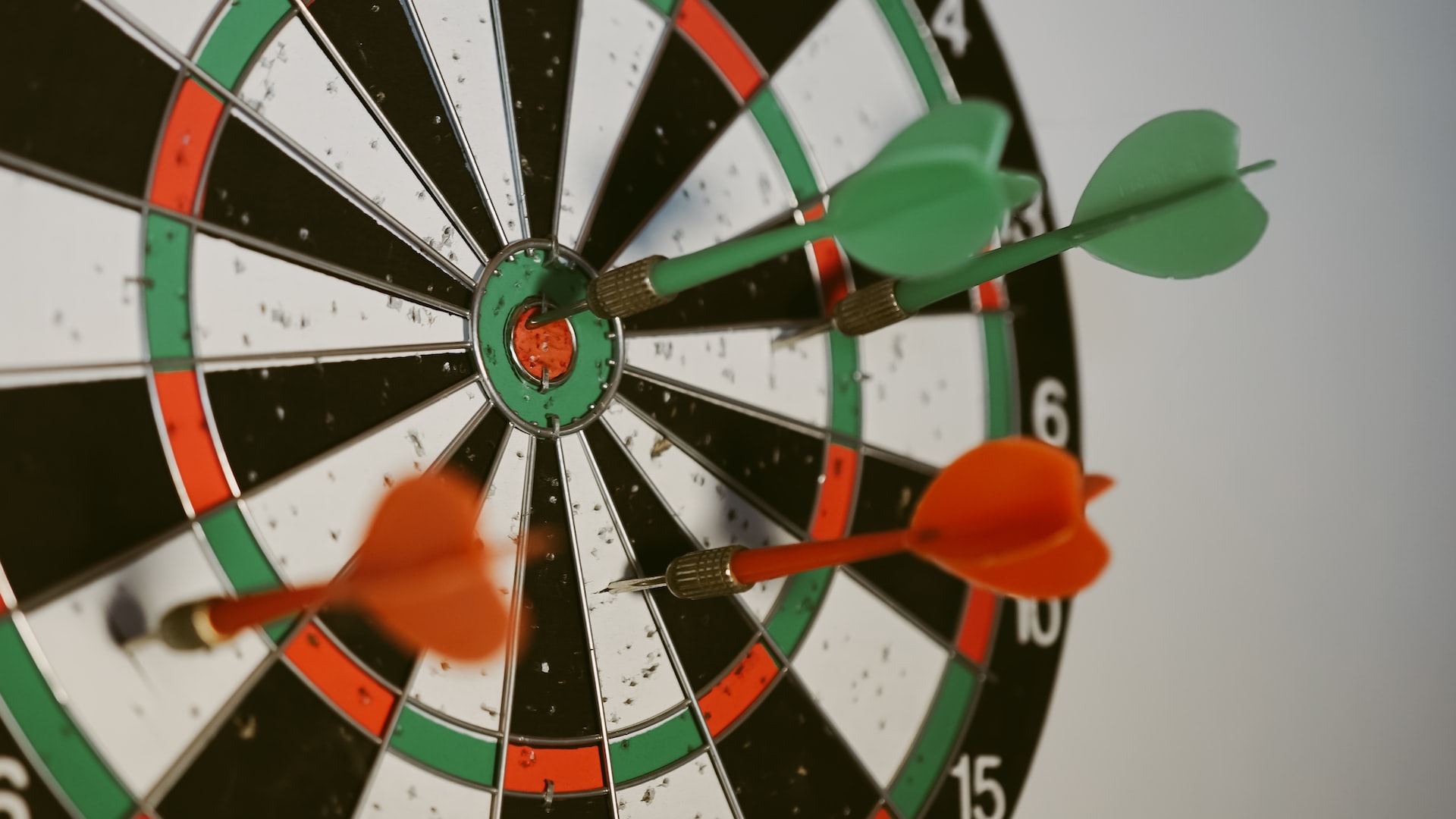
CALLS – How is funding made available?
National and regional authorities make funding from ERDF and RRF available to projects. Funding programmes approved by the European Commission, national, and regional authorities (Operational Programme for ERDF, Cooperation Programme for Interreg or National Recovery and Resilience Plan), inform about concrete measures and publish programmes and calls for proposals.
Sometimes, calls for proposals are developed in line with national or regional strategies on tourism or in the context of new support programmes.
During a programming period multiple calls will be launched. Single calls are generally thematically organised. As such it becomes easier for the authorities to manage the promotion activities and selection procedures.
When embedded in national or regional support programmes, regular annual calls (or even several calls in one year) are possible. An open application process is also possible, where applications can be submitted all the time in a longer timeframe.
General information on specific measures and programmes might be already presented within the national RRP documents. In some countries, recent national or regional tourism already define specific action lines and measures that will surely be implemented in the next months and years with projects and grant schemes.
In 2021-2027, most ERDF national and regional programmes as well as Interreg programmes in the Mediterranean region, will address tourism. In a few programmes this is explicitly covered via programme priorities. In most programmes funding is available via horizontal measures and calls e.g., calls not explicitly referring to tourism, but that can still be relevant for tourism players. For example, the Interreg EUROMED PROGRAMME 2021-2027 addresses sustainable tourism transversally in all Programme priorities, to allow MED regions to practice a tourism governance that enables continuous improvements of environmental, social, and economic sustainability and increases competitiveness through quality and innovations.
The next section on CONTEXT will present more information on national and regional strategies and how they align with RRP and ERDF funding.
Some recommendations can be useful to ensure a swift and effective implementation of measures via calls for grant schemes:
Authorities who launch calls should:
→ Consider the timing of the calls and allow enough time for applicants to react.
→ Optimise the outreach to possible applicants, for example by informing, in due time, the relevant tourism associations, business associations, cluster or intermediaries such as Chambers of commerce. These organisations can be involved in communication of call information.
→ Be as clear as possible about target groups, eligibility, type of actions and requirements that are linked to funding.
→ Provide explanations and supporting documents (templates, guidance, manual for applicants) to reduce the workload for applicants.
→ Plan time after the launch of the call for interactive information and answering questions from applicants, for example, via Q&A web sessions, FAQ documents or explanatory videos on YouTube.
Potential applicants should:
→ Be aware and alert that many relevant calls might now be launched in a relatively short time, especially in the context of RRP funds that have to be spent by 2024.
→ Keep an eye on and regularly check programme websites related to national RRP or of Ministries in charge of tourism.
→ Subscribe to Newsletters related to national RRP or to information from tourism organisations that usually inform about new funding opportunities.
→ Join seminars or information sessions (also web-based) organised by national or regional authorities.
→ Register now for online submission platforms that might be used for the web-based application process and get yourself familiar with the system. In some countries, submission of applications can now be only done via these submission platforms.
→ Establish contacts with business support organisations or potential service providers (e.g. on renovation or digitisation measures) to see exactly what would be feasible and needed in a project. Ask for a first indicative budget proposal.
→ Plan ahead and make sufficient capacities available to prepare the application, maybe hire extra staff or join forces with other companies or local development agencies.
In the RRP of Cyprus, Component 3.1 refers to establish a new growth model and diversification of the economy, including the promotion of a sustainable tourism sector.
Sub-component 3.1.3. foresees concrete measures in the tourism sector, especially on increasing the added value of the tourism sector with emphasis on the countryside, mountainous and remote areas:
Grant scheme on financing the renovation of accommodation establishments / hotels in the countryside, mountainous and remote areas to modernise and increase competitiveness of the tourism product.
Grant scheme on renovation of traditional restaurants or businesses selling traditional products subject to their inclusion in the label “taste of Cyprus”.
Grant scheme on repurposing of accommodation establishments / hotels to include medical and assisted living facilities to attract health wellness and medical tourism.
Part of the French National Recovery and Resilience Plan is the Fund for sustainable tourism. The fund consists of an investment envelop of EUR 50 million for sustainability measures in rural tourism establishments (accommodation and restauration). Possible measures focus on reducing food waste, or better use of water and heating. The 30 regional chambers of commerce support the national agency for ecological transition (ADEME) in the implementation of these funds.
There is a specific call on slow tourism that aims to assist players to develop slow tourism products. Slow tourism is defined as a form of tourism based on a chosen time, immersive and experiential, guaranteeing well-being and a break in the rhythm of life, with low greenhouse gas emissions, and respecting the environment and the host populations.
Two types of projects are envisaged: on the one hand support for diagnosis, advice, and development, on the other support for design, facilitation, and implementation of projects. To be eligible, all the project's actions must be consistent with the imperatives of the green transition: limiting the consumption of energy and resources; promoting energy efficiency; improving capacity to protect against the consequences of climate change; promoting the circular economy.
Will all Calls be published by the Ministry for Tourism?
No, calls can also be launched from other Ministries, Departments or Funding Agencies. They will probably address horizontal priorities and schemes where SMEs and/or companies from all sectors can apply if the requirements are fulfilled. This can also include touristic establishments, restaurants, or other tourism companies. These calls might address, for example, energy efficiency measures, circular approaches and waste reduction, new forms of management, digital transformation, modernisation, training, and skills.
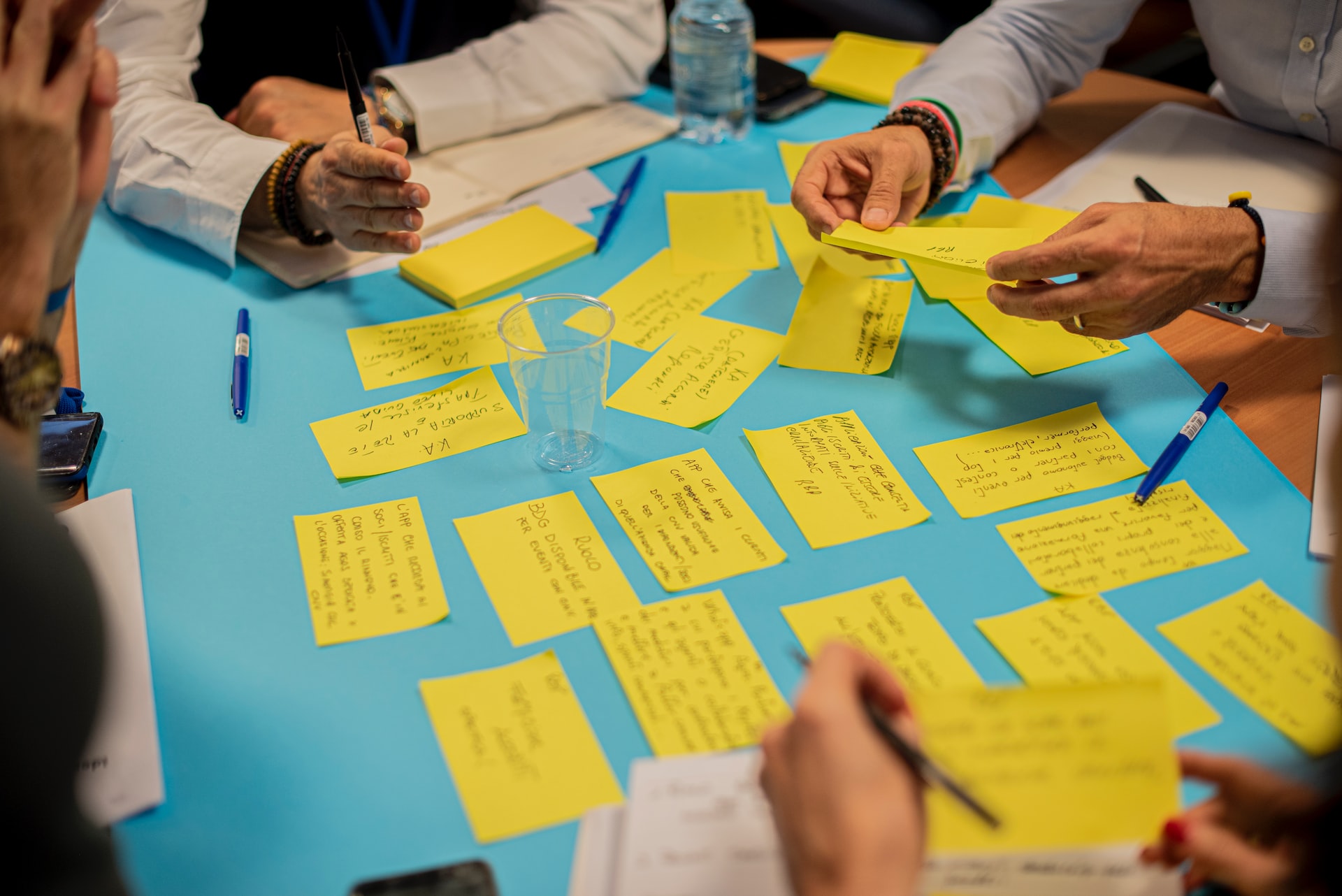
CONTEXT - How to have strong project ideas?
The best project ideas address societal challenges. Project results shall be beneficial for specific end-users and ideally have long term effects. Projects create added value by introducing a new type of service, facilitating the development of a new product, or enhancing partnerships. An entity’s regular activities are usually not financed. Programme documents as well as local, regional, and national tourism strategies provide good guidance to relate projects ideas to societal issues and opportunities.
To understand which measures exactly are eligible for funding it is necessary to understand what the tourism sector wants to achieve – at national, regional, and local level. Strategies and Action Plans are necessary tools to agree with all stakeholders on long-term goals and necessary measures, instruments, and milestones.
Strategies represent the context in which calls for RRP and ERDF funding are embedded. Strategies and Action Plans also help to integrate and organise measures from different Ministries and Line Departments (e.g. on SME and Business Development, Digital Development, Ecology and Environment and Tourism).
Strategies help to avoid sectoral silo-thinking and help to structure support to the tourism sector from an integrated territorial point of view.
In this sense, it is highly recommendable that countries, regions, and even local destinations develop strategies for sustainable tourism, easing the framing of funding programmes and calls towards the relevant tourism development objectives.
Overall, it is highly recommended to know and understand the most recent tourism strategies. This will be not only helpful for potential applicants but also for funding authorities or intermediary organisations such as chambers of commerce, cluster or local tourism agencies. These can be national strategies or regional strategies, such as in larger countries like Spain, France, and Italy. Strategies at either level offer an important framing of future funding measures and grant schemes.
Strong projects will fit perfectly into the action lines of relevant tourism strategies.
Some recommendations can be useful to generate strong project ideas:
Authorities who launch calls should:
→ Develop programmes and calls based on recent tourism strategies.
→ Consider other public authorities who might launch calls in the same thematic area to avoid overlaps.
→ Learn about positive examples and pilots from INTERREG projects and other pilot projects. Take on board lessons learned and mainstream good ideas into general support.
→ Define calls for specific territories. The needs of businesses in rural areas are different from the ones in larger cities.
Potential applicants should:
→ Respond to the objectives of the funding programme.
→ Align the investments you planned to do with the objectives and thematic areas of strategic documents in your region/country.
→ Inspire programme authorities on funding needs by highlighting results from pilot actions (e.g. from Interreg projects) and expressing needs in tourism strategies.
→ Start developing a local or micro strategy that fits with an overarching strategy.
→ Read the most recent strategies and think how you can develop a project that fits with the overall objectives and action lines. This will help prepare for future calls.
→ Look for external support and assistance while developing a project idea. See more on this in the section on CAPACITIES.
Component 14 of the Spanish RRP is on modernisation and competitiveness of the Spanish tourism sector. A specific Plan was elaborated that addresses the modernisation of the sector from a strategic and comprehensive perspective. He plan has different areas of action:
1) The transformation of the tourism model towards sustainability.
2) The digital transformation of tourism destinations and companies.
3) The implementation of specific resilience plans in extra-peninsular territories.
4) Boosting competitiveness through the development of the tourism product, energy efficiency and the circular economy in the sector, investment in the maintenance and rehabilitation of historical heritage for tourist use and in the improvement of commercial areas with a high tourist inflow.
Programmes in these areas will be implemented via calls for tenders. Some of them will be made by ministries, others by state-owned public companies, others by the Autonomous Communities and by local councils at municipal level. One of the first measures to implement this Plan was the definition of a specific programme (‘Extraordinary Programme for Tourism Sustainability in Destinations 2021-2023’). A call for the presentation of ‘Territorial Tourism Sustainability Plans for Destinations’ for this extraordinary programme was presented in July 2021.
The +Sustainable Tourism Plan 2020-2023 was presented in June 2021 by Turismo do Portugal. It aims to support the recovery of the Portuguese tourism sector towards sustainability. It highlights the challenges that are pressuring the tourism sector, for example, circular economy and climate change. The +Sustainable Tourism Plan 2020-2023 builds on the “Reactive Tourism / Build the Future” Plan approved by the Portuguese Government in its Pillar 4 “Sustainability in companies and destinations”.
The Plan includes 119 actions distributed by 4 Axes. Actions are, for example, the definition of the tourism carrying capacity of territories for planning purposes, the integration of measures targeting the tourism sector in all Regional Circular Economy Transition Agendas, or the introduction of a - national certification for water efficiency “AQUA+ Hotels”.
The Italian Recovery and Resilience Plan with a budget of 6.675 billion euro, sets out the lines of action relating to culture, including them in the third component of Mission 1, dedicated precisely to Tourism and Culture. The investments planned for Culture 4.0 amount to €4.275 billion, to which are added the investments of the Strategic Plan for Major Cultural Attractions amounting to €1.460 billion, in the Complementary Fund used to finance 14 interventions for the protection, enhancement and promotion of culture.
500 million euro has been allocated specifically for the development of digital platforms and strategies for the use of cultural heritage. These funds are for 12 projects aimed at: developing, organising, and preserving the digital heritage of archives, libraries, museums, and cultural sites; developing new ways for users to use the heritage; and developing cloud infrastructures and software for managing digital resources.
Another action line aims to support the economic and social development of the many small Italian villages and historic centres that offer enormous potential thanks to the cultural heritage, history and traditions that characterise them. A model will be developed to direct tourism towards more sustainable visitor flows by promoting visits to lesser known places.
Canarias Destino is the transformation strategy that Canary Islands Tourism proposes to the sector and to the rest of the agents in the Canary Islands tourism ecosystem. The Strategy explains that the competitiveness of the Canary Islands as a tourist destination cannot continue to depend only on constant growth, in the number of accommodation places and flights to the Islands. The "new competitiveness" will require a solid capacity for transformation. Its three objectives are in line with the Recovery and Resilience Fund: Objective 1) Improving the resilience of the Canarias tourism model; Objective 2) Increasing its commitment to climate neutrality; and Objective 3) Enhancing its capacity to generate value for the economy and citizens of the Canary Islands.
In 2021, Andalucía published its new Strategy Plan META 2027. The support and advice to SMEs at regional level, for example, will concentrate now on the following areas: “creation, dissemination and marketing of tourism products, use and application of new technologies in the tourism sector, languages, tourism micro-enterprises: creation and management of SMEs, tourism regulations and legislation, incentives and aid, quality certification, as well as internationalisation of companies.” Financial support to SMEs will be offered via aid schemes. The Plan foresees the use of ERDF and EARDF funds but does not mention explicitly the RRP funds.
The Balearic Investment Strategy 2030 defines extraordinary measures to implement the actions and projects to be financed with RRP funds in the region. The Strategy is a programmatic planning document to advance in the transformation of the economic and social model of the Balearic Islands along four axes: economic diversification, sustainability, competitiveness, and social cohesion, which are deployed in twelve strategic action lines. Many projects are infrastructure measures that will help to make the tourism more sustainable by saving water and resources, and by reducing energy and emissions.”.
In 2021, Slovenia and the World Tourism Organisation prepared and coordinated a Digital Transformation Strategy with all Slovenian tourism stakeholders. This includes the following sets for each stakeholder group: digitalisation in marketing, impact on customer journey, digitisation in sales, digitisation of processes / business - management, aspect of internal processes in the introduction of new technologies (personnel, technological solutions, decision support processes in organisation of work…), management of tourist flows (destinations, attractions), and digitisation for greater attractiveness and safety of tourism products. Following the development of the strategy, several workshops will be held within the Digital Academy for training of key stakeholders in the field of digital transformation. Workshops will enable stakeholders to receive all the necessary information on the importance, areas, and scope of digital transformations. The purpose of the workshops is to raise awareness of the importance of digitisation and to gain practical information on the implementation of the transformation. The workshops will be designed for both professionals the public (tourism industry, leading destinations of Slovenian tourism) and local communities (municipalities, tourist associations, other interested parties).
Do I need to align project ideas to programme priorities?
Yes, successful projects contribute to achieving programme objectives. In doing so, project ideas need to relate to programme logics and proof contributions via monitoring and reporting. Project proposals speaking the language of programme authorities may be more likely to receive funding. Local or regional authorities, as well as some destination management organisations or external experts, may guide and assist applicants to relate project ideas to programme objectives. In doing so, tourism strategies are important tools to relate needs and opportunities from the start, as strategies are used by programme authorities to draft programmes and define specific calls. As such strategies help to reflect funding needs on funding programmes.
CONDITIONS – Which requirements need to be fulfilled?
EU investments shall address public needs and respect transparency and competition standards, like any other public investment. In doing so, programme authorities need to set up different procedures and define specific criteria to fund initiatives. For funding authorities, this often requires the development of new routines and use of expert knowledge on different fields, such as state aid and public procurement rules, ecological standards, cost options, and electronic systems for communication and reporting. Management authorities of funding programmes need to set up respective systems to comply with these requirements and clearly communicate the need and use of these systems to their beneficiaries. Among the key elements to consider are electronic reporting systems, state aid, and public procurement requirements.
State Aid. Public investments may not distort competition or create any unfair advantage for one business over the other. Public investments, including ERDF and RRF investment, therefore need to respect European State Aid rules. Programme authorities need to consider these rules when setting up their calls, and provide the necessary information and tools for applicants to deliver the justification for not breaching state aid law. Programme authorities may introduce, for example, maximum ceilings of investments, to make sure that the investment falls below state aid threshold, so-called De Minimis levels. Programme authorities may also use General Block Exemption Rules applicable in a country, e.g., for certain SMEs. As such they may ask for statements justifying investments in small and medium-size companies.
Public Procurement Rules. Beneficiaries of RRP funds or ERDF may need support from external parties, e.g., for the construction of infrastructure, legal advisory services etc. As beneficiaries of public investments, public procurement rules shall be followed when contracting externals. Depending on the financial size of the services different rules may apply, for example asking for at least three offers to allow selection of the most adequate partner. Programme authorities generally provide guidance to beneficiaries on the application of public procurement rules.
Co-funding. European funding generally does not cover the full investment need of tourism activities. Investments via the ERDF need additional funding. National, regional, and local authorities may co-fund the activities, or programme authorities may ask beneficiaries to ensure private funding in combination with the ERDF-investment. The share of co-funding differs per region. Following the ERDF’s objective to rebalance socioeconomic development between European regions, fewer additional investments are needed in well-developed regions. Beneficiaries in the least developed regions, e.g., in Southern Italy, large parts of Greece, Croatia, Andalucía, Castilla-la-Mancha and Alentejo, receive up to 85% of their investment from the ERDF. Beneficiaries in the most developed regions, e.g., Catalunya and regions in Northern Italy and western Slovenia, receive up to 50% of their investment from the ERDF. National authorities may also oblige private cofunding for RRF investments. Beneficiaries of the French sustainable tourism programme receive grants for 50% of the investment costs.
Specific requirements of Recovery and Resilience Plans. Regarding the new RRP funds, some requirements are new and come on top of the previously known conditions. National RRP measures should contribute to the green transition, reducing contribution to climate change and protection of the biodiversity and to the digital transformation. All interventions funded under the RRP will need to show if and how they contribute to the green transition, including biodiversity. At least 37 % of the recovery and resilience plan’s total allocation are dedicated to green transition, in addition to the minimum 20% of national RRP allocation dedicated to the digital transition. Therefore, it will usually be necessary for projects presented to the RRP to carry out a climate and environmental contribution labelling. In each country, there will be specific methodologies for these processes called ‘climate tracking’ and ‘digital tagging’. For potential applicants this means that any link to climate and environmental contribution or to digital modernisation will surely be beneficial for a project application.
Aspects such as keeping track of climate relevant actions or of digital measures funded by the RRP, as well as the integration of the ‘Do no significant harm’ (DNSH) principle, need to be taken into account by all stakeholders. Considering these aspects in due time helps to set up effective administrative support systems and develop useful guidance.
The ‘Do No Significant Harm’ principle. All RRP investments and most other EU funded investments will need to show that they do not cause significant damage to the environment. They will need to follow the ‘Do no significant harm’ principle. In some cases, proof compliance with this principle is already provided at the level of the NRRP. In other cases, beneficiaries of funding need to provide proof to not do specific harm, for example by a self-declaration or by compliance to national or regional criteria for sustainability, e.g., having an energy efficiency or green tourism label. In other cases, only certain types of investment may be eligible for funding e.g., energy saving lights or installing public lights that limit light pollution.
Programme and fund managers shall invest in systems, procedures, awareness raising and capacity building activities to limit administrative burden at the level of final beneficiaries. At the same time, any beneficiary shall be aware that EU funding, like any other public investment, comes with administrative tasks. Many aspects need to be documented, reported, and evidence provided. Potential applicants need to be aware that some paperwork needs to be done and that, for example, documents need to be stored and saved for a considerable number of years, in case audits and controls ask for them.
All actions carried out within the Spanish National Recovery and Resilience Plan must comply with the principle of not causing significant damage to the following environmental objectives: a) climate change mitigation, b) adaptation to climate change, c) sustainable use and protection of water and marine resources, d) the circular economy, e) the prevention and control of pollution, f) the protection and recovery of biodiversity and ecosystems. The importance of this requirement is crucial. Any failure to comply will lead to exclude actions from funding.
For this reason, the Spanish Ministry for the Ecological Transition and the Demographic Challenge presents a DNSH Guide with recommendations to adapt both the design and the development of the actions funded under the National Recovery and Resilience Plan to the DNSH principle.
It is foreseen that each measure will have to fill in a corresponding self-assessment questionnaire and sign a declaration of compliance with the principle of "no significant harm" to the six environmental objectives.
Where do I find information on requirements?
Call documents provide all necessary information to respect specific programme requirements for RRF and ERDF. This requires careful reading of the call information, including reviewing templates to complete.
Programmes may host events to present and clarify specific requirements. Utilising these opportunities may help to better understand the requests for supporting documents, delivery of monitoring data, and terminology. Additionally, specific service providers may help tourism players to meet the requirements to obtain European funding. When doing so, it is important for the tourism player to express its expected results and objectives of the investment to ensure proper translation of project ideas to proposals in the language of the programme authority.

CAPACITIES – How to develop high-quality projects?
For the RRP and ERDF programmes it is crucial to develop project ideas and applications in a short time, to carry out projects in a timely manner, and to deliver good quality.
Some, especially small players such as local tourism agencies and SMEs, might find this challenging and could need help to develop project ideas and applications. Larger players, such as regional tourism boards, destination management organisations, and tourism agencies need to prepare themselves to support the smaller players in multiple ways and to take the lead in larger integrated projects that represent local and regional destinations.
Many projects require collaboration with partners from the tourism ecosystem. While it might sound weird to cooperate with the ‘competitor’, the tourism ecosystem view tells us that all tourism stakeholders in a destination are linked together and are perceived as one system by the visitors. Therefore, collaborative projects will become very important in promoting sustainable tourism.
Some recommendations can be useful to develop high-quality projects:
Larger players should:
→ Follow-up closely on information published by ministries and on RRP websites.
→ Develop newsletters or documents for members or local tourism stakeholders to inform regularly about funding news.
→ Offer information sessions (interactive) to inform members or tourism stakeholders about funding opportunities and clarify requirements and eligibility.
→ Have staff trained and prepared to work on applications that refer to a local or regional destination as a whole.
→ Offer support and guidance to check project ideas and proposals from small players.
Small players should:
→ Appoint a person responsible for the (administrative and financial) management of a potential project.
→ Connect to support organisations (DMO, chamber of commerce, clusters, business associations) to learn in due time about new funding opportunities, e.g., via newsletters, phone calls, website searches.
→ Look for external support and assistance while planning (and implementing) a project, e.g., on administrative management or reporting.
→ Look early for partners or service providers, e.g., on IT or environmental standards, and develop project ideas with them in order to already be able to give many details of the project in the application.
→ Take part in trainings on “effective project development” or “management of EUfunded projects”
→ If you already have ideas for projects, meet support organisations (DMOs, chamber of commerce, clusters, business associations) to get advice on how they are best presented and to which call.
The Barcelona Provincial Council has elaborated a report to explain the conditions and requirements of the Spanish Recovery and Resilience Plan for the tourism stakeholders. This report gives advice to the local entities interested in tourism measures and for tourism companies. The document defines the next steps to follow for interested stakeholders:
1. Contact the main administrations responsible for the execution of the submeasures.
2. Start preparing proposals from the Diputació de Barcelona itself in accordance with the guidelines set out in the document in component 14 on tourism of the Spanish RRP.
3. Inform and train local bodies to start preparing proposals, especially regarding Tourism Sustainability Plans in Destinations.
4. Monitor the calls that are being published, both component 14 and other components that may be of interest.
In September 2021, the Regional Authority of Mallorca together with the Mallorca Chamber of Commerce, created a Project Management Office. This will provide support on Next Generation EU funds to municipalities with less than 20,000 inhabitants in Mallorca, as well as Alcúdia. The aim of this office is to offer advice and technical support to the town councils and help them to process projects aimed at obtaining Next Generation funds. The European Project Management Office will be attached to the Department of the Presidency and will have staff specialised in European Funds.
Its functions include the following:
- Advising local councils on the viability of projects that could be financed with these funds.
- Creating synergies between municipalities to assess the possibility of joint projects.
- Identifying the appropriate calls for proposals that are adapted to the projects.
- Supporting the processing of applications, management and justification of projects.
In addition to the NextGenerationEU funds, this new office will also be able to manage projects financed through other resources coming from the EU, such as funds from ordinary calls for proposals under ERDF and ESF, and other municipal or supra-municipal projects that affect shared competences. The Mallorca Consell contributes approx. EUR 1 million to this project during the four years that the office will be operational. For its part, the Chamber of Commerce will have the physical office, computer equipment, and necessary staff. The office is expected to give a boost to the digital transition, ecological, social, and territorial cohesion at municipal level.
In early 2022, the Interreg Euro-MED Academy was launched. This joint initiative of the Interreg MED communities and PANORAMED shares lessons learnt via online courses (MOOC). It will develop capacities of EU funds implementing bodies, policy makers, and beneficiaries of EU funds. The first online course open for registration to any interested user was entitled “Promoting Innovation for Sustainable Transitions in the Mediterranean”. This course is structured around a number of issues related to the appropriate action to take to overcome environmental and societal challenges, especially in the Mediterranean basin. The course presents concrete tools that can be used by policy makers. The academy will include courses and lessons on the use of ERDF, the 2021-2027 Interreg EURO-MED programme, and on enhancing sustainable tourism. Access and registration to the platform is free.
What is a high-quality project?
High quality projects contribute to the objectives described in funding programmes. These objectives address specific territorial and socioeconomic needs and opportunities. As such individual projects help to make a change in the area covered by the programme. Therefore, high quality projects deliver concrete results, that is results that are meaningful for their target group. In doing so, high quality projects may include different partners to bring together the right knowledge and expertise to reach the target group. Also, high quality projects monitor and assess their progress to 1) adapt activities to remain focused on their contribution if needed and 2) show their contribution to programme objectives quantitatively and qualitatively.
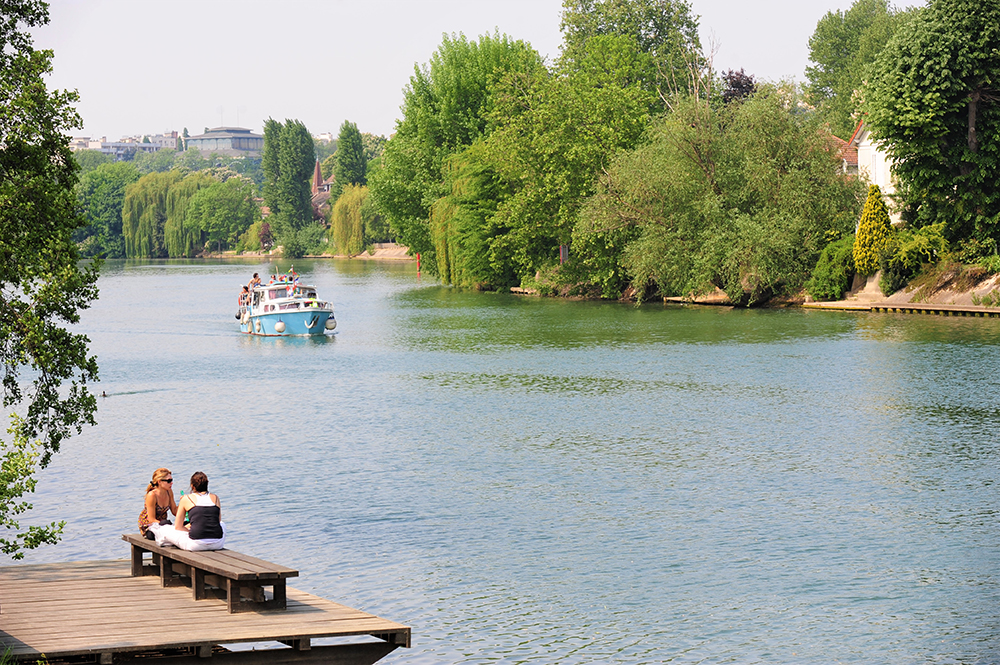
Continuous Capacity Building
This chapter provides a further outlook to continue making use of available EU funds in Mediterranean countries, with concrete support from the Interreg MED Sustainable Tourism Community.
Making good use of available EU funding to boost sustainable tourism requires continuous capacity building. Capacity building describes a process of developing and strengthening skills, instincts, abilities, processes, and resources that organisations and communities need to survive, adapt, and thrive in a fast-changing world. Aligning EU funds with needs and opportunities for sustainable tourism is subject to different changes. Programme authorities’ staff, for example, need to remain up to date on the use of the latest programming and monitoring tools and on the needs of their target group, and ensure swift allocation of available funding to relevant projects. Applicants and beneficiaries need to be aware of new and upcoming calls, requirements, and electronic application and monitoring systems. Together, programme authorities and beneficiaries need to remain in contact to make sure that funding addresses specific needs and opportunities. Such exchanges can take place per region, country, or across countries.
Lessons from other regions or countries provide external views and out-of-the-box lessons on programme management and implementation. As such, exchanges with peers working in other institutional contexts help to build capacities and stimulate making good use of EU funds. European territorial cooperation (Interreg) is a great instrument that supports cross-national exchanges and offers incentives for continuous capacity building.
Different initiatives encourage and support cross regional and national exchanges to advance capacity building on the use of EU funds for sustainable tourism.
INTERREG programmes, such as EURO MED 2021-27, provide funding to build capacities, develop common solutions, cooperate with partners from other countries, and develop joint strategies. Local and regional authorities as well as destination management organisations, private partners, and research institutes may benefit from the transnational cooperation programme. Sustainable tourism is one of the four missions of the programme. Besides this transnational programme, cross border programmes support capacity building activities as well. An overview of programmes is available via https://interreg.eu/. Links to programme websites and managing authorities can be accessed via this webpage.
In addition to Interreg programmes, the European Commission offers different capacity building opportunities. Programme authorities can, among other benefits, enhance their capacities via the TAIEX Peer 2 Peer programme or DG REGIO Communities of practice. Such schemes provide platforms for programme authorities to enhance their knowledge on programme development and implementation. An overview of capacity building schemes can be accessed via the Commission’s webpage.
Networking and exchange also take place beyond ERDF funding programmes. European Regions for competitive and sustainable tourism are united in NECSTouR. This network provides an important link between regional and wider European levels of government, highlighting the importance of tourism as a driver for sustainable development and competitiveness. Network members have a common voice to highlight the need for funding and cooperation at European level. Their activities go thus beyond the RRF and ERDF and address all European support to sustainable tourism.
This handbook is a relevant tool for MED Managing Authorities and national, regional, and local authorities, or other European tourism stakeholders, on how to integrate solutions to change their approach on tourism funding or accelerate the tourism transition to sustainability in their programmes.
The main objective of Interreg Italy-Croatia is to strengthen a more strategic and coordinated management of tourism that encourages development of alternative and special interest tourism, with an aim to improve employment in the tourism sector. Within this programme beneficiaries could be public bodies and authorities, private companies, tourism organisations, NGOs, civil society organisations or local action groups.
This Programme will support projects that:
- Foster experiential tourism.
- Develop marketing campaigns with a goal of boosting the diversification of tourism in peripheral areas.
- Establish cross-border sustainable brands and pilot projects.
- Organise training activities for public authorities and tour operators on sustainable tourism.
- Carry out joint assessment studies of trends and impacts of tourism.
Stakeholders in the Adriatic Ionian region (in the context of the Interreg ADRION programme) expressed needs and opportunities for cooperation to restart tourism following the COVID-19 Pandemic.
Stakeholders expressed a need for:
- Digitalisation
- Skills development and capacity building
- Entrepreneurship and innovation
- Diversification and customisation
- Safety and security
- Sustainable mobility
- Protection and preservation
- Accessible and inclusive tourism
Each of the topics relate to the possible funding opportunities as presented under: “CONTENT – what can be funded”. The results of this survey among ADRION stakeholders thus illustrates the possibilities to use Interreg to build capacities, seek coordination, and perform pilot projects before using national and regional funding from ERDF and RRF to enhance sustainable tourism.
Where can I find more information on lessons from Interreg Sustainable Tourism?
Key lessons from the Interreg MED Sustainable Tourism Community are shared via the Community’s webpage. The webpage includes a catalogue of more than 40 project outputs from more than 20 projects across the Mediterranean, as well as policy factsheets, recommendations, and capitalisation deliverables. A new updated version is planned for Summer 2022.
Lessons learnt and more information on the use of Interreg and results of the Interreg Mediterranean programme can be found via the Interreg Euro-MED Academy or the future report on Good Practices for Capitalisation.
